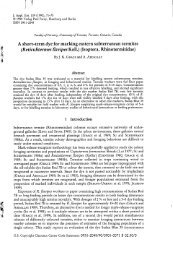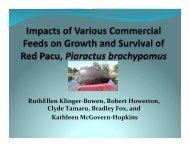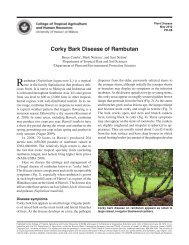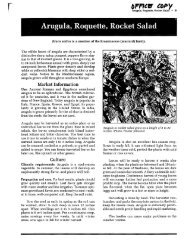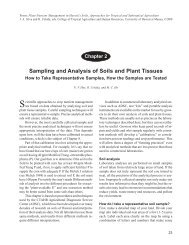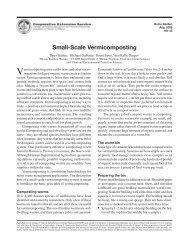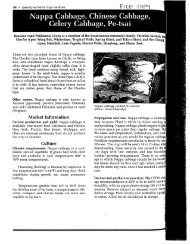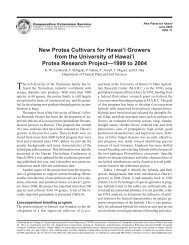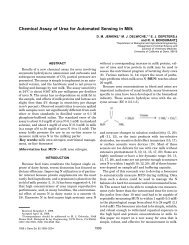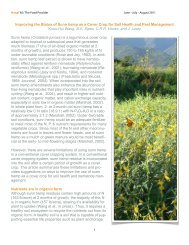Disease Index for the Rust Puccinia psidii on Rose Apple in ... - ctahr
Disease Index for the Rust Puccinia psidii on Rose Apple in ... - ctahr
Disease Index for the Rust Puccinia psidii on Rose Apple in ... - ctahr
You also want an ePaper? Increase the reach of your titles
YUMPU automatically turns print PDFs into web optimized ePapers that Google loves.
<str<strong>on</strong>g>Disease</str<strong>on</strong>g> <str<strong>on</strong>g>Index</str<strong>on</strong>g> <str<strong>on</strong>g>for</str<strong>on</strong>g> <str<strong>on</strong>g>the</str<strong>on</strong>g> <str<strong>on</strong>g>Rust</str<strong>on</strong>g><br />
<str<strong>on</strong>g>Pucc<strong>in</strong>ia</str<strong>on</strong>g> <str<strong>on</strong>g>psidii</str<strong>on</strong>g><br />
<strong>on</strong> <strong>Rose</strong> <strong>Apple</strong> <strong>in</strong> Hawai‘i<br />
Robert C. Anders<strong>on</strong> 1,2 and Janice Y. Uchida 2<br />
1 U.S. Geological Survey, Pacific Island Ecosystems Research Center<br />
2 UH-CTAHR Department of Plant and Envir<strong>on</strong>mental Protecti<strong>on</strong> Sciences<br />
College of Tropical Agriculture and Human Resources<br />
UNIVERSITY OF HAWAI‘I AT MÄNOA
2<br />
Introducti<strong>on</strong><br />
In 2005, <str<strong>on</strong>g>Pucc<strong>in</strong>ia</str<strong>on</strong>g> <str<strong>on</strong>g>psidii</str<strong>on</strong>g>, an <strong>in</strong>vasive fungus caus<strong>in</strong>g guava rust <strong>in</strong> Brazil,<br />
was discovered <strong>on</strong> potted plants of ‘öhi‘a (Metrosideros polymorpha), <strong>on</strong><br />
O‘ahu. This rust <strong>in</strong>fects several members of <str<strong>on</strong>g>the</str<strong>on</strong>g> Myrtaceae, <strong>in</strong>clud<strong>in</strong>g rose<br />
apple and paperbark, but thus far <strong>in</strong>fecti<strong>on</strong>s of <str<strong>on</strong>g>the</str<strong>on</strong>g> comm<strong>on</strong> guava have<br />
been rare. Ured<strong>in</strong>iospores are <str<strong>on</strong>g>the</str<strong>on</strong>g> most comm<strong>on</strong> type of spores <str<strong>on</strong>g>for</str<strong>on</strong>g>med by<br />
this rust. These bright yellow spores are spherical with t<strong>in</strong>y sp<strong>in</strong>es, easily<br />
airborne, and have resulted <strong>in</strong> distributi<strong>on</strong> of <str<strong>on</strong>g>the</str<strong>on</strong>g> disease to all major islands<br />
<strong>in</strong> Hawai‘i.<br />
<strong>Rose</strong> apple (Syzygium jambos) has been devastated <strong>in</strong> parts of <str<strong>on</strong>g>the</str<strong>on</strong>g> state<br />
exposed to extended periods of moist wea<str<strong>on</strong>g>the</str<strong>on</strong>g>r. The disease also occurs <strong>in</strong><br />
dry areas, but is less severe. Pers<strong>on</strong>nel with <str<strong>on</strong>g>the</str<strong>on</strong>g> federal government, such<br />
as <str<strong>on</strong>g>the</str<strong>on</strong>g> U.S. Forest Service, U.S. Geological Survey, and APHIS, and state<br />
agencies, such as <str<strong>on</strong>g>the</str<strong>on</strong>g> Department of Land and Natural Resources and <str<strong>on</strong>g>the</str<strong>on</strong>g><br />
Department of Agriculture, are c<strong>on</strong>cerned about <str<strong>on</strong>g>the</str<strong>on</strong>g> extent of <str<strong>on</strong>g>the</str<strong>on</strong>g> rust’s<br />
movement <strong>in</strong> Hawai‘i. Thus ef<str<strong>on</strong>g>for</str<strong>on</strong>g>ts to survey <str<strong>on</strong>g>for</str<strong>on</strong>g>ests, surround<strong>in</strong>g plant<br />
communities, and commercial nurseries were deemed to be of high priority.<br />
Hikers and agency field workers can aid <strong>in</strong> this survey. To ga<str<strong>on</strong>g>the</str<strong>on</strong>g>r helpful<br />
data, observati<strong>on</strong>s of locati<strong>on</strong>s of <str<strong>on</strong>g>the</str<strong>on</strong>g> rust, <str<strong>on</strong>g>the</str<strong>on</strong>g> disease severity, and <str<strong>on</strong>g>the</str<strong>on</strong>g><br />
envir<strong>on</strong>mental c<strong>on</strong>diti<strong>on</strong>s are important. To help organize <str<strong>on</strong>g>the</str<strong>on</strong>g> disease<br />
survey, this disease <strong>in</strong>dex <strong>on</strong> rose apple, <str<strong>on</strong>g>the</str<strong>on</strong>g> most severely <strong>in</strong>fected host,<br />
was prepared.<br />
Young tissues that are diseased will be covered with few to many spots<br />
(Category 3 or 4). Spores (ured<strong>in</strong>iospores) are <str<strong>on</strong>g>for</str<strong>on</strong>g>med <strong>in</strong> groups called<br />
pustules <strong>on</strong> <str<strong>on</strong>g>the</str<strong>on</strong>g> leaf spot. Leaf spots that are old will have <strong>on</strong>ly a few<br />
ured<strong>in</strong>iospores, and older spores become white, but <str<strong>on</strong>g>the</str<strong>on</strong>g> t<strong>in</strong>y sp<strong>in</strong>es rema<strong>in</strong>.<br />
On older spots, pustules that are slightly more orange or brown c<strong>on</strong>ta<strong>in</strong> twocelled<br />
teliospores that are l<strong>on</strong>ger and have no sp<strong>in</strong>es. Teliospores can occur<br />
<strong>in</strong> any category <strong>on</strong> older lesi<strong>on</strong>s or spots and can be <str<strong>on</strong>g>for</str<strong>on</strong>g>med al<strong>on</strong>g with<br />
ured<strong>in</strong>iospores <strong>in</strong> <str<strong>on</strong>g>the</str<strong>on</strong>g> same pustule.<br />
This is CTAHR Plant <str<strong>on</strong>g>Disease</str<strong>on</strong>g> publicati<strong>on</strong> PD-37, Feb. 2008.<br />
On <str<strong>on</strong>g>the</str<strong>on</strong>g> cover<br />
<strong>Rose</strong> apple tree <strong>in</strong>fected with <str<strong>on</strong>g>Pucc<strong>in</strong>ia</str<strong>on</strong>g> <str<strong>on</strong>g>psidii</str<strong>on</strong>g> al<strong>on</strong>g Häna Highway, Maui, March 2007 (photograph<br />
by Forest and Kim Starr).<br />
Photo credits: Photos of Category 4 leaf and stem distorti<strong>on</strong> and Category 5 branch tip dieback<br />
and severely diseased stand were taken by Forest and Kim Starr; all o<str<strong>on</strong>g>the</str<strong>on</strong>g>r photographs were<br />
taken by R. Anders<strong>on</strong>.<br />
Published by <str<strong>on</strong>g>the</str<strong>on</strong>g> College of Tropical Agriculture and Human Resources (CTAHR) and issued <strong>in</strong> fur<str<strong>on</strong>g>the</str<strong>on</strong>g>rance of Cooperative<br />
Extensi<strong>on</strong> work, Acts of May 8 and June 30, 1914, <strong>in</strong> cooperati<strong>on</strong> with <str<strong>on</strong>g>the</str<strong>on</strong>g> U.S. Department of Agriculture. Andrew G. Hashimoto,<br />
Director/Dean, Cooperative Extensi<strong>on</strong> Service/CTAHR, University of Hawai‘i at Mänoa, H<strong>on</strong>olulu, Hawai‘i 96822.<br />
An equal opportunity/affirmative acti<strong>on</strong> <strong>in</strong>stituti<strong>on</strong> provid<strong>in</strong>g programs and services to <str<strong>on</strong>g>the</str<strong>on</strong>g> people of Hawai‘i without regard to<br />
race, sex, age, religi<strong>on</strong>, color, nati<strong>on</strong>al orig<strong>in</strong>, ancestry, disability, marital status, arrest and court record, sexual orientati<strong>on</strong>, or<br />
status as a covered veteran. CTAHR publicati<strong>on</strong>s can be found <strong>on</strong> <str<strong>on</strong>g>the</str<strong>on</strong>g> website www.<strong>ctahr</strong>.hawaii.edu/freepubs.
A series of disease <strong>in</strong>dexes is be<strong>in</strong>g prepared to describe <str<strong>on</strong>g>the</str<strong>on</strong>g> <str<strong>on</strong>g>Pucc<strong>in</strong>ia</str<strong>on</strong>g> rust<br />
disease and to aid <strong>in</strong> m<strong>on</strong>itor<strong>in</strong>g it. In additi<strong>on</strong> to this <strong>in</strong>dex <strong>on</strong> rose apple,<br />
o<str<strong>on</strong>g>the</str<strong>on</strong>g>rs <strong>on</strong> ‘öhi‘a and o<str<strong>on</strong>g>the</str<strong>on</strong>g>r P. <str<strong>on</strong>g>psidii</str<strong>on</strong>g> hosts such as paperbark (Melaleuca<br />
qu<strong>in</strong>quenervia) and Eugenia are be<strong>in</strong>g prepared.<br />
Any<strong>on</strong>e help<strong>in</strong>g with this survey is s<strong>in</strong>cerely appreciated and should report<br />
f<strong>in</strong>d<strong>in</strong>gs to <strong>on</strong>e of <str<strong>on</strong>g>the</str<strong>on</strong>g> researchers listed <strong>on</strong> <str<strong>on</strong>g>the</str<strong>on</strong>g> back cover. If you observe<br />
symptoms o<str<strong>on</strong>g>the</str<strong>on</strong>g>r than those described here, or if you have questi<strong>on</strong>s, please<br />
c<strong>on</strong>tact <str<strong>on</strong>g>the</str<strong>on</strong>g> authors.<br />
<str<strong>on</strong>g>Disease</str<strong>on</strong>g> symptoms<br />
<strong>Rose</strong> apple is a highly susceptible host to <str<strong>on</strong>g>Pucc<strong>in</strong>ia</str<strong>on</strong>g> <str<strong>on</strong>g>psidii</str<strong>on</strong>g> rust <strong>in</strong> Hawai‘i and<br />
elsewhere. <strong>Rose</strong> apple leaves, stems, fruit, and flowers can be affected, and<br />
<str<strong>on</strong>g>the</str<strong>on</strong>g> disease severity varies with <str<strong>on</strong>g>the</str<strong>on</strong>g> time of year. This plant is naturalized <strong>in</strong><br />
<str<strong>on</strong>g>the</str<strong>on</strong>g> Hawaiian Islands <strong>in</strong> mesic to wet sites at elevati<strong>on</strong>s of 15–500 m (50–<br />
1650 ft), primarily <strong>in</strong> valleys and occasi<strong>on</strong>ally <strong>in</strong> disturbed mesic <str<strong>on</strong>g>for</str<strong>on</strong>g>ests.<br />
Symptom severity is based <strong>on</strong> <str<strong>on</strong>g>the</str<strong>on</strong>g> age of <str<strong>on</strong>g>the</str<strong>on</strong>g> plant tissue, <str<strong>on</strong>g>the</str<strong>on</strong>g> envir<strong>on</strong>mental<br />
moisture and temperature, and <str<strong>on</strong>g>the</str<strong>on</strong>g> amount of time s<strong>in</strong>ce <strong>in</strong>fecti<strong>on</strong>. Young leaf<br />
tissues are usually most heavily diseased by <str<strong>on</strong>g>the</str<strong>on</strong>g> rust and typically become<br />
blighted and de<str<strong>on</strong>g>for</str<strong>on</strong>g>med.<br />
Wet wea<str<strong>on</strong>g>the</str<strong>on</strong>g>r symptoms<br />
Moisture is needed <str<strong>on</strong>g>for</str<strong>on</strong>g> <strong>in</strong>fecti<strong>on</strong>, and disease severity <strong>in</strong>creases dur<strong>in</strong>g ra<strong>in</strong>y<br />
or humid wea<str<strong>on</strong>g>the</str<strong>on</strong>g>r. Often, young tissues will be heavily <strong>in</strong>fected with<br />
ured<strong>in</strong>iospores (Category 4, page 8) dur<strong>in</strong>g wet wea<str<strong>on</strong>g>the</str<strong>on</strong>g>r, while older leaves<br />
may have <strong>on</strong>ly a few lesi<strong>on</strong>s or spots (Category 1, page 5, or Category 2,<br />
page 6). When severely <strong>in</strong>fected, leaves are blighted and de<str<strong>on</strong>g>for</str<strong>on</strong>g>med, and<br />
stems and leaves are often abundantly covered with yellow ured<strong>in</strong>iospores.<br />
The ured<strong>in</strong>iospores are <str<strong>on</strong>g>the</str<strong>on</strong>g> repeat<strong>in</strong>g stage of <str<strong>on</strong>g>the</str<strong>on</strong>g> rust, and <str<strong>on</strong>g>the</str<strong>on</strong>g>y <strong>in</strong>crease <str<strong>on</strong>g>the</str<strong>on</strong>g><br />
epidemic by <strong>in</strong>fect<strong>in</strong>g new hosts or host tissue <strong>in</strong> <str<strong>on</strong>g>the</str<strong>on</strong>g> vic<strong>in</strong>ity or miles away.<br />
Heavily <strong>in</strong>fected leaves usually blacken and die, and after a m<strong>on</strong>th or so fall<br />
off, leav<strong>in</strong>g <strong>on</strong>ly blackened stem tips (Category 5, page 9).<br />
Dry wea<str<strong>on</strong>g>the</str<strong>on</strong>g>r symptoms<br />
On young leaf tissue dur<strong>in</strong>g dry wea<str<strong>on</strong>g>the</str<strong>on</strong>g>r, <strong>in</strong>stead of <str<strong>on</strong>g>the</str<strong>on</strong>g> whole leaf becom<strong>in</strong>g<br />
diseased, <strong>in</strong>dividual lesi<strong>on</strong>s approximately 3–5 mm ( 1 ⁄8– 3 ⁄16 <strong>in</strong>ch) <strong>in</strong> diameter<br />
<str<strong>on</strong>g>for</str<strong>on</strong>g>m. Adjacent lesi<strong>on</strong>s sometimes coalesce to become 10 mm ( 3 ⁄8 <strong>in</strong>ch) or<br />
more <strong>in</strong> diameter. The lesi<strong>on</strong>s are reddish and have yellow ured<strong>in</strong>iospores. As<br />
<str<strong>on</strong>g>the</str<strong>on</strong>g> leaves mature, <str<strong>on</strong>g>the</str<strong>on</strong>g> spots rema<strong>in</strong> (Category 1 or 2), but fewer spores are<br />
<str<strong>on</strong>g>for</str<strong>on</strong>g>med. Six to eight weeks after <str<strong>on</strong>g>the</str<strong>on</strong>g> <strong>in</strong>itial <strong>in</strong>fecti<strong>on</strong>, spore <str<strong>on</strong>g>for</str<strong>on</strong>g>mati<strong>on</strong> is rare.<br />
3
Mak<strong>in</strong>g evaluati<strong>on</strong>s <strong>in</strong> <str<strong>on</strong>g>the</str<strong>on</strong>g> field<br />
• For all sites, record <str<strong>on</strong>g>the</str<strong>on</strong>g> host plant, locati<strong>on</strong>, date, and disease category (as<br />
described below). A survey <str<strong>on</strong>g>for</str<strong>on</strong>g>m is provided <strong>on</strong> page 11.<br />
• For locati<strong>on</strong>, GPS coord<strong>in</strong>ates are ideal. Lack<strong>in</strong>g a GPS device, if you are <strong>on</strong><br />
a trail, you can note which part you are <strong>on</strong> by estimat<strong>in</strong>g <str<strong>on</strong>g>the</str<strong>on</strong>g> distance traveled<br />
(first quarter of <str<strong>on</strong>g>the</str<strong>on</strong>g> trail, half way al<strong>on</strong>g, etc.), or you can note some land<br />
feature (near a certa<strong>in</strong> stream, ridge, etc.); if near a highway, give its name<br />
and nearest milepost marker if available.<br />
• Determ<strong>in</strong>e if <str<strong>on</strong>g>the</str<strong>on</strong>g> rust is present at a site by check<strong>in</strong>g all sides of at least five<br />
trees; if no rust is found, <str<strong>on</strong>g>the</str<strong>on</strong>g> site’s record is zero (absence of <str<strong>on</strong>g>the</str<strong>on</strong>g> rust at a site<br />
is useful <strong>in</strong><str<strong>on</strong>g>for</str<strong>on</strong>g>mati<strong>on</strong>). For tall trees, check <str<strong>on</strong>g>the</str<strong>on</strong>g> lower canopy and make a note<br />
of <str<strong>on</strong>g>the</str<strong>on</strong>g> tree size.<br />
• Place specimens <strong>in</strong> separate bags and wipe hands with a moist tissue be<str<strong>on</strong>g>for</str<strong>on</strong>g>e<br />
handl<strong>in</strong>g a new plant. Avoid touch<strong>in</strong>g healthy plants if you have handled<br />
plants with heavy <strong>in</strong>fecti<strong>on</strong> levels. Wip<strong>in</strong>g hands is recommended after each<br />
sampl<strong>in</strong>g. Although movement of <str<strong>on</strong>g>the</str<strong>on</strong>g> pathogen is largely by <str<strong>on</strong>g>the</str<strong>on</strong>g> w<strong>in</strong>d and ra<strong>in</strong><br />
splash, c<strong>on</strong>tact can also move spores.<br />
• In <str<strong>on</strong>g>the</str<strong>on</strong>g> field, evaluators should rate a site or tree us<strong>in</strong>g <str<strong>on</strong>g>the</str<strong>on</strong>g> highest category <str<strong>on</strong>g>for</str<strong>on</strong>g><br />
<str<strong>on</strong>g>the</str<strong>on</strong>g> rat<strong>in</strong>g. When a tree is severely <strong>in</strong>fected and young stems are covered with<br />
spores, <str<strong>on</strong>g>the</str<strong>on</strong>g> disease is Category 4, even if <str<strong>on</strong>g>the</str<strong>on</strong>g> older leaves have <strong>on</strong>ly a few<br />
spots (Category 1 or 2). Note <str<strong>on</strong>g>the</str<strong>on</strong>g> category of <str<strong>on</strong>g>the</str<strong>on</strong>g> older leaves, buds, flowers,<br />
and fruits, if present. When a tree has <strong>on</strong>ly old growth with dead branch tips,<br />
<str<strong>on</strong>g>the</str<strong>on</strong>g> disease is Category 5, but you should also make a note if <str<strong>on</strong>g>the</str<strong>on</strong>g>re are o<str<strong>on</strong>g>the</str<strong>on</strong>g>r<br />
leaves <strong>in</strong> Category 1 to 3, and check <str<strong>on</strong>g>for</str<strong>on</strong>g> any o<str<strong>on</strong>g>the</str<strong>on</strong>g>r plant parts, such as<br />
flowers, that may be diseased.<br />
4
Category 1<br />
• Ten spots or fewer per leaf, each spot about<br />
2 mm ( 1 ⁄16 <strong>in</strong>ch) to more than 10 mm ( 3 ⁄8 <strong>in</strong>ch)<br />
<strong>in</strong> diameter.<br />
• Leaves have few ured<strong>in</strong>iospores and, if present,<br />
few teliospores.<br />
This category <strong>in</strong>dicates that young leaves were<br />
<strong>in</strong>fected when <str<strong>on</strong>g>the</str<strong>on</strong>g> <strong>in</strong>oculum level was very low,<br />
<str<strong>on</strong>g>the</str<strong>on</strong>g> envir<strong>on</strong>ment was dry, or <str<strong>on</strong>g>the</str<strong>on</strong>g> leaf was mature<br />
enough to express some resistance. These leaves<br />
matured, develop<strong>in</strong>g <strong>on</strong>ly a few spots.<br />
Abaxial<br />
(leaf undersurface)<br />
Close-up of leaf spots<br />
and empty pustules<br />
Adaxial<br />
(leaf upper surface) Abaxial<br />
5
Category 2<br />
• More than 10 spots per leaf.<br />
• Leaf spots may merge, caus<strong>in</strong>g <str<strong>on</strong>g>for</str<strong>on</strong>g>mati<strong>on</strong> of<br />
larger necrotic areas that are 25 mm (1 <strong>in</strong>ch) or<br />
more l<strong>on</strong>g.<br />
• Ured<strong>in</strong>iospores are few, and teliospores may be<br />
present.<br />
• Shot-holes, created by <str<strong>on</strong>g>the</str<strong>on</strong>g> loss of <str<strong>on</strong>g>the</str<strong>on</strong>g> diseased<br />
tissue, may also be present.<br />
As <strong>in</strong> Category 1, this level of spott<strong>in</strong>g may reflect<br />
a low <strong>in</strong>oculum level, low envir<strong>on</strong>mental humidity,<br />
or host resistance due to leaf maturity at <str<strong>on</strong>g>the</str<strong>on</strong>g> time<br />
<str<strong>on</strong>g>the</str<strong>on</strong>g> leaves were <strong>in</strong>fected.<br />
6<br />
Close-up of leaf spot and<br />
empty pustules<br />
Abaxial Abaxial Adaxial
Category 3<br />
• Occurs <strong>on</strong> young leaves.<br />
• Less than 30 percent of <str<strong>on</strong>g>the</str<strong>on</strong>g> leaf area<br />
is covered with rust pustules.<br />
• Leaves are not severely <strong>in</strong>fected, and<br />
stem lesi<strong>on</strong>s are rare.<br />
• Check <str<strong>on</strong>g>for</str<strong>on</strong>g> presence of teliospores.<br />
This generally represents <strong>in</strong>fecti<strong>on</strong> of<br />
young tissue when <str<strong>on</strong>g>the</str<strong>on</strong>g> envir<strong>on</strong>ment was<br />
dry.<br />
Close-up of two clusters of pustules<br />
(groups of ured<strong>in</strong>iospores)<br />
Adaxial, few spores Abaxial, many pustules and ured<strong>in</strong>iospores<br />
7
Category 4<br />
• Severe <strong>in</strong>fecti<strong>on</strong> of young leaves and<br />
new growth, with as much as 80–100<br />
percent of <str<strong>on</strong>g>the</str<strong>on</strong>g> leaf surface covered<br />
with lesi<strong>on</strong>s.<br />
• Leaves may be de<str<strong>on</strong>g>for</str<strong>on</strong>g>med, curled, or<br />
distorted.<br />
• Lesi<strong>on</strong>s present <strong>on</strong> stems.<br />
• Ured<strong>in</strong>iospores are produced <strong>in</strong> large<br />
numbers and frequently fall like<br />
powder <strong>on</strong>to <str<strong>on</strong>g>the</str<strong>on</strong>g> lower leaves.<br />
• Check <str<strong>on</strong>g>for</str<strong>on</strong>g> presence of teliospores.<br />
Dur<strong>in</strong>g this epiphytotic (or plant epidemic),<br />
heavy rust growth and pustule<br />
<str<strong>on</strong>g>for</str<strong>on</strong>g>mati<strong>on</strong> causes young tissues to<br />
produce de<str<strong>on</strong>g>for</str<strong>on</strong>g>med new growth covered<br />
with yellow ured<strong>in</strong>iospores.<br />
8<br />
Abaxial leaf<br />
surface<br />
Close-up of stem<br />
lesi<strong>on</strong>s and<br />
ured<strong>in</strong>ia, or<br />
pustules<br />
De<str<strong>on</strong>g>for</str<strong>on</strong>g>med apical tip and red,<br />
de<str<strong>on</strong>g>for</str<strong>on</strong>g>med leaves De<str<strong>on</strong>g>for</str<strong>on</strong>g>med leaves and stem
Category 5<br />
• Leaves become necrotic (blackened) and abscise (drop from <str<strong>on</strong>g>the</str<strong>on</strong>g> stem).<br />
• Branch tips are severely diseased and bare of leaves (photo below, and p. 10).<br />
Follow<strong>in</strong>g an epiphytotic <strong>on</strong> <str<strong>on</strong>g>the</str<strong>on</strong>g> young leaves, stems tips have no leaves and are<br />
brown or blackened. Dead branch tips are present <strong>in</strong> <str<strong>on</strong>g>the</str<strong>on</strong>g> upper canopy of <str<strong>on</strong>g>the</str<strong>on</strong>g><br />
tree. Mature green leaves have Category 1 and 2 disease levels. New leaves<br />
produced <strong>on</strong> lower branches also become <strong>in</strong>fected (Category 3 or 4).<br />
Necrotic (dead) young leaves caused by severe <strong>in</strong>fecti<strong>on</strong> (Category 4)<br />
Close-up of branch tip dieback (new leaves circled)<br />
9
Category 5 (c<strong>on</strong>t<strong>in</strong>ued)<br />
<strong>Rose</strong> apple stand with severely diseased<br />
plants, Huelo, Maui<br />
10<br />
Infected fruit<br />
O<str<strong>on</strong>g>the</str<strong>on</strong>g>r symptoms<br />
Pustules may be present <strong>on</strong> rose<br />
apple buds, flowers, and fruits.<br />
Infected <strong>in</strong>florescence<br />
Infected bud, open<strong>in</strong>g<br />
For fur<str<strong>on</strong>g>the</str<strong>on</strong>g>r <strong>in</strong><str<strong>on</strong>g>for</str<strong>on</strong>g>mati<strong>on</strong><br />
http://nt.ars-gr<strong>in</strong>.gov/taxadescripti<strong>on</strong>s/factsheets/<br />
<strong>in</strong>dex.cfm?thisapp=<str<strong>on</strong>g>Pucc<strong>in</strong>ia</str<strong>on</strong>g><str<strong>on</strong>g>psidii</str<strong>on</strong>g><br />
www.hear.org/species/pucc<strong>in</strong>ia_<str<strong>on</strong>g>psidii</str<strong>on</strong>g><br />
For survey <str<strong>on</strong>g>for</str<strong>on</strong>g>m<br />
www.<strong>ctahr</strong>.hawaii.edu/oc/<str<strong>on</strong>g>for</str<strong>on</strong>g>ms/rustsurvey.pdf
Field survey <str<strong>on</strong>g>for</str<strong>on</strong>g> <str<strong>on</strong>g>Pucc<strong>in</strong>ia</str<strong>on</strong>g> <str<strong>on</strong>g>psidii</str<strong>on</strong>g> rust disease<br />
Host observed: � rose apple � ‘�hi‘a o<str<strong>on</strong>g>the</str<strong>on</strong>g>r __________________________________<br />
Use a separate <str<strong>on</strong>g>for</str<strong>on</strong>g>m <str<strong>on</strong>g>for</str<strong>on</strong>g> each host/observati<strong>on</strong>.<br />
Collector _____________________ date __/__/__ ph<strong>on</strong>e/e-mail ________________________<br />
� sample taken; sample no. _____________________________________________________<br />
(Sample number might <strong>in</strong>clude your <strong>in</strong>itials, <str<strong>on</strong>g>the</str<strong>on</strong>g> date, and a sequence number; e.g., RA 4/15/08–2.<br />
Please give this <str<strong>on</strong>g>for</str<strong>on</strong>g>m to <str<strong>on</strong>g>the</str<strong>on</strong>g> researcher al<strong>on</strong>g with <str<strong>on</strong>g>the</str<strong>on</strong>g> sample.)<br />
Envir<strong>on</strong>ment � nursery � natural locati<strong>on</strong><br />
island __________ locati<strong>on</strong> ________________________ trail/road ______________________<br />
trail secti<strong>on</strong>/milepost ________________________________ elev. (est.) __________________<br />
GPS ___________________________________________________________________________<br />
������������������������������������������������������������������������<br />
Descripti<strong>on</strong> of plant<br />
� young ����������������������������������� <strong>in</strong> decl<strong>in</strong>e, repeated loss of young leaves<br />
plant size ______________________________________________________________________<br />
For ‘�hi‘a: � leaves pubescent (hairy) � leaves glabrous (smooth)<br />
����������������������������������������������������������������������������������<br />
<str<strong>on</strong>g>Rust</str<strong>on</strong>g> occurrence leaf spots/rust spores � not observed � present<br />
disease <strong>in</strong>dex category: � 1 � 2 � 3 � 4 � 5 (check all that apply)<br />
�������������������������� � 4 sides of host checked, at least 2–3 branches <strong>on</strong> each<br />
side exam<strong>in</strong>ed; _______ sides checked and branches exam<strong>in</strong>ed; � <strong>on</strong>ly 1 side observed<br />
<str<strong>on</strong>g>Disease</str<strong>on</strong>g> present � mostly <strong>on</strong> young leaves � mature leaves � old leaves � all leaves<br />
Extent of rust <strong>in</strong>fecti<strong>on</strong> <strong>in</strong> area: � 1 tree <strong>on</strong>ly � a few trees � many trees � all<br />
trees <strong>in</strong> <str<strong>on</strong>g>the</str<strong>on</strong>g> area have some <strong>in</strong>fecti<strong>on</strong><br />
Nearby <strong>in</strong>fected host plants � rose apple � ‘�hi‘a � paperbark � java plum<br />
� mounta<strong>in</strong> apple � bush cherry � downy rose myrtle � Eugenia re<strong>in</strong>wardtiana<br />
o<str<strong>on</strong>g>the</str<strong>on</strong>g>rs _________________________________________________________________________<br />
O<str<strong>on</strong>g>the</str<strong>on</strong>g>r Metrosideros species present:<br />
� rugosa � macropus � waialealae � tremuloides<br />
M. polymorpha varieties present (specify) __________________________________________<br />
Comments:<br />
������������������� <strong>in</strong>itials _______ date __________ � ured<strong>in</strong>iospores � teliospores<br />
11
Please submit rust survey results to <str<strong>on</strong>g>the</str<strong>on</strong>g>se researchers:<br />
O‘ahu<br />
Janice Y. Uchida. Dept. of Plant and Envir<strong>on</strong>mental Protecti<strong>on</strong> Sciences, College of<br />
Tropical Agriculture and Human Resources (CTAHR), University of Hawai‘i at Mänoa,<br />
St. John Hall 304, 3190 Maile Way, H<strong>on</strong>olulu, HI 96822; 808-956-2827;<br />
juchida@hawaii.edu<br />
Robert Anders<strong>on</strong>. Pacific Island Ecosystems Research Center, U.S. Geological<br />
Survey, 677 Ala Moana Blvd Ste 615, H<strong>on</strong>olulu, HI 96813; 808-587-7459;<br />
rob_anders<strong>on</strong>@usgs.gov<br />
Robert Hauff. Div. of Forestry and Wildlife, Hawai‘i Dept. of Land and Natural<br />
Resources, 1151 Punchbowl St Rm 325, H<strong>on</strong>olulu, HI 96813; 808-587-4174;<br />
robert.d.hauff@hawaii.gov<br />
Maui<br />
Norman Nagata. Cooperative Extensi<strong>on</strong> Service (CES), CTAHR, 310 Ka‘ahuamanu<br />
Ave, Bldg 214, Kahului, HI 96732; 808-244-3242 (ext. 230);<br />
nagatan@<strong>ctahr</strong>.hawaii.edu<br />
Big Island<br />
Scot Nels<strong>on</strong>. CES, CTAHR, 875 Komohana St, Hilo, HI 96720 (mail <strong>on</strong>ly);<br />
920 Sta<strong>in</strong>back Hwy, Pana‘ewa (<str<strong>on</strong>g>for</str<strong>on</strong>g> visits and courier service); 808-981-8265;<br />
nels<strong>on</strong>@hawaii.edu<br />
J.B. Friday. CES, CTAHR, 875 Komohana St., Hilo, HI 96720 (mail <strong>on</strong>ly);<br />
920 Sta<strong>in</strong>back Hwy, Pana‘ewa (<str<strong>on</strong>g>for</str<strong>on</strong>g> visits and courier service); 808-981-8265;<br />
jbfriday@hawaii.edu<br />
Anne Marie LaRosa. Inst. <str<strong>on</strong>g>for</str<strong>on</strong>g> Pacific Islands Forestry, USDA Forest Service;<br />
60 Nowelo St, Hilo, HI 96720; 808-933-8121 (ext. 115); alarosa@fs.fed.us<br />
Kaua‘i<br />
Jeri Ooka. Kaua‘i Agricultural Research Center, CTAHR, 7370-A Kuamo‘o Rd,<br />
Kapa‘a, HI 96746; 808-822-4984 (ext. 226 or 228); jeri@hawaii.edu<br />
We greatly appreciate any f<strong>in</strong>d<strong>in</strong>gs of new hosts. If you f<strong>in</strong>d a plant not menti<strong>on</strong>ed<br />
<strong>in</strong> this publicati<strong>on</strong> that may have <str<strong>on</strong>g>the</str<strong>on</strong>g> rust, please submit it to Janice Uchida, Robert<br />
Anders<strong>on</strong>, Robert Hauff, Scot Nels<strong>on</strong>, Norman Nagata, or Jeri Ooka. We will c<strong>on</strong>firm<br />
<str<strong>on</strong>g>the</str<strong>on</strong>g> pathogen and report back to you.<br />
College of Tropical Agriculture and Human Resources<br />
UNIVERSITY OF HAWAI‘I AT MÄNOA



